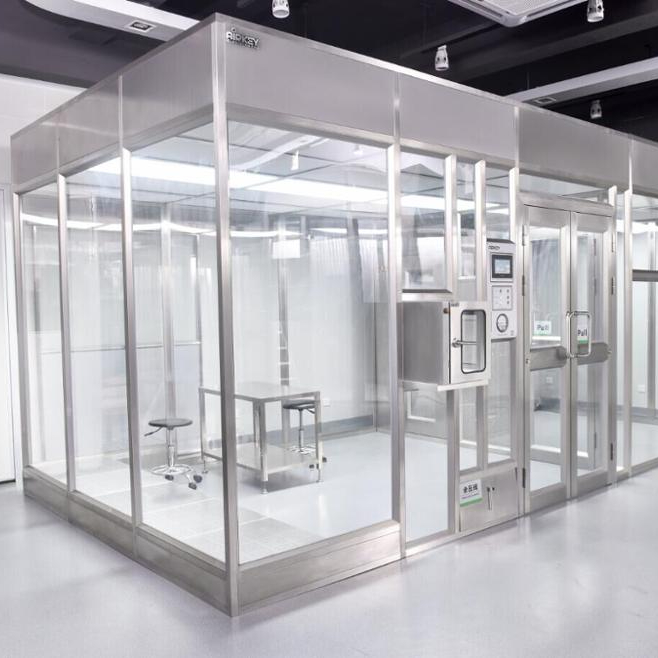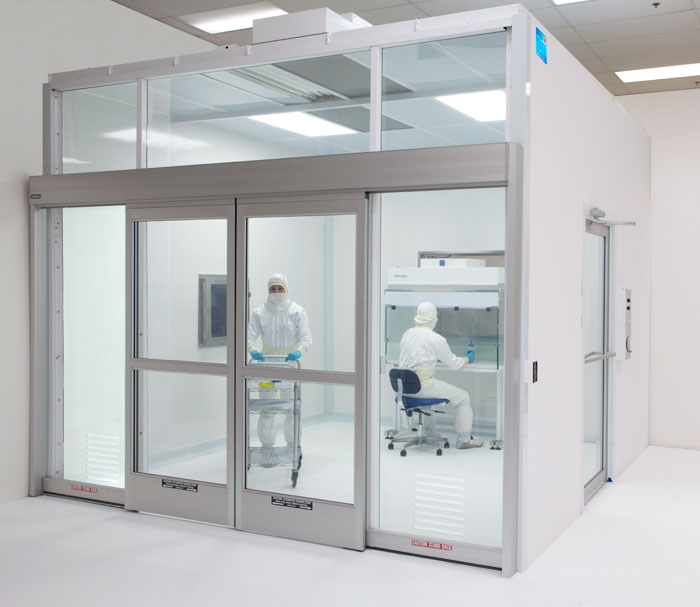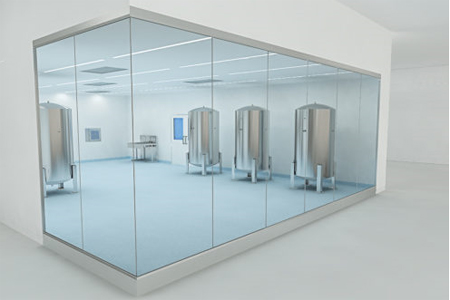Modular clean rooms feature hard wall construction mounted between anodized aluminum posts to create a fully enclosed area. When compared to soft clean rooms, the rigid wall construction allows for increased volumes of internal air pressure, which helps to minimize dirty air from entering the room. This type of hard wall design provides for a better and more consistent performance. Modular clean rooms are easy to assemble and reassemble and are recommended for ISO Class 5-8 cleanrooms.
Modular cleanrooms are designed for outstanding performance and aesthetic appeal. We design and manufacture recirculating and non-recirculating modular cleanrooms in a range of standard sizes and configurations, as well as custom modular clean rooms that are tailored to your unique specifications.

A modular clean room is a cleanroom with factory pre-cut components that is assembled on site. Modular cleanrooms can quickly and easily be disassembled and reassembled for application changes. Modular design is valued for its low-cost materials, basic construction and overall versatility.
Modular ceiling panels are designed as per Co-ordination with HVAC lighting system to better clean room facility , performance & Appearance.
Clean Lab
Clean labs or clean rooms offer facilities that have controlled levels of contamination free from microbial, particulate and moisture impurities. These are the perfect manufacturing conditions for delicate industries such as electronics, biotechnology and life sciences. Clean labs are used in laboratories for medical or pharmaceutical research. They do not necessarily require FDA validation, though clean rooms designed to produce medical and pharmaceutical products do. They may be stationary or mobile. The levels of contamination control, sterility and environmental control they require depends on if they contain biohazards or potentially explosive, flammable or corrosive materials. Housed within these clean labs equipment such as lithography, etching, metrology, polishing and microscopy can perform in optimal conditions.
Advantages of clean working zones:
- the principle of the modular cleanroom can be transferred to work benches, individual cabins and mini environments
- individual modules are easy to connect and tailor to customer requirements
- systematic use of the available space
- provides an improvement in the purity class also outside the work surfaces
Positive Air Pressure Cleanroom
Positive air pressure clean rooms are clean rooms in which more filtered air is pumped into them than exists in the space outside of them. They seek to keep contaminated air out of the room. Positive air pressure cleanrooms are only used for applications that do not involve hazardous substances. This is because, during the operation of positive air pressure cleanrooms, some air will escape from the walls, ceiling or doors.
Negative Air Pressure Cleanroom
Negative air pressure cleanrooms use negative pressure to remove contaminated air from the room. Once the air is evacuated, it must be replaced with clean air. The source of this air is either the evacuated air, which has been run through filters, or fresh filtered air. Negative air pressure cleanrooms are required for cleanroom applications that involve hazardous chemicals, whether they be biohazardous or flammable, potentially explosive, etc.

Incorporation of Equipment components
Clean rooms generally come with an air quality control system of some type, like air filters, fans, and pumps. The best kept clean rooms have air flow that is controlled by directional air filters that encourage a laminar air flow; using laminar air flow ensures that new, filtered air continuously cycles into the clean room and removes any lingering contamination. Common and highly effective filters used in cleanrooms include High Efficiency Particulate Air (HEPA) filters and Ultra Low Particulate Air (ULPA) filters. HEPA filters can trap particles sized .3 microns and larger. ULPA filters provide an even more rigorous performance.
Inside clean rooms, you may find cleanroom furniture, such as a cleanroom table, cleanroom wall, laminar flow bench or laminar flow hood.
Note that, to keep from tracking in particles, operators and other personnel must don proper clean room apparel; humans shed 100,000 particles of dead skin cells per minute just while standing! Apparel to cover up human skin and hair, which is around 100 micrometers wide, includes shoe covers, beard covers, bouffant caps and face masks, as well as accessories like approved cleaning wipes. In addition, these efforts may be amplified by the use of air showers, which are small rooms in which personnel step to rinse off prior to entering a clean room.
Benefits
Cleanrooms are fantastic, and there are a number of reasons to choose them for your application. First, with impurities gone, your system or the product you’re working is far less likely to malfunction or break down. Second, you can work on, study or use far more sensitive materials or technology than you could without a cleanroom. This is because, without a cleanroom, those items would be compromised and your work would be rendered inaccurate, unsafe or inefficient. By using a cleanroom, you are also able to cultivate and surround your product with a miniature or even micro environment. For instance, by establishing constant positive pressure within your cleanroom, you can create a clean room environment that contains leaks. Or, by creating a cleanroom environment with constantly low humidity, you can control electrostatic discharge. Finally, thanks to each of the advantages you’re gaining, with a clean room, you’ll also find yourself saving time, money and energy, while gaining a reputation for better work or products.
COMPARISON BETWEEN SELECTED EQUIVALENT OF FS 209E AND ISO 14644-1
| ISO 14644-1 | FS 209E |
|---|---|
| ISO 3 | Class 1 |
| ISO 4 | Class 10 |
| ISO 5 | Class 100 |
| ISO 6 | Class 1,000 |
| ISO 7 | Class 10,000 |
| ISO 8 | Class 100,000 |
Our Cleanroom Design and Customization
When designing a clean room, manufacturers focus on making sure that it is a space in which the environment is sufficiently controlled and particulates are sufficiently kept out. How they go about that depends on the application and its requirements. For example, clean rooms may be permanently established, or they may have a portable or modular design. Permanent clean rooms and the machines that regulate their conditions are usually incorporated into the structures of the buildings that house them. Sometimes, though, they are enclosed by clear plastic walls or glass instead.

Manufacturers also customize their designs by size and material. Cleanrooms may be warehouse-sized, as they often are for microelectronics, circuitry, and pharmaceutical product manufacturing; these are called ballrooms. Alternatively, when built for small-scale medical testing, repairs, or limited, exclusive, or specialized operations, they may be only the size of home kitchen ovens.
Selected materials have to meet the strict criteria so that the clean room can be effective. Namely, they cannot contribute to air contamination. Like softwall clean room materials, general cleanroom construction materials must be non-fibrous, non-static electricity-generating and non-corrosive. Even stainless steel is sometimes avoided, because it can corrode when exposed to bleach. Common materials from which clean room components are made include: acrylic (economical, easy to clean, tintable, great tensile strength), static dissipative PVC (protects against electrostatic discharge and particulate contamination), polycarbonate (high tensile strength, shatter resistant, acid resistant, cleaning solution resistant, solvent resistant), tempered glass (clear, broadly chemical resistant, non-porous, easy to clean) and polypropylene (superior chemical and acid resistance).
There is no end to the custom cleanroom supplies and accessories that manufacturers may add to your cleanroom system. Examples of these include: electric heaters, smoke detectors, intercoms, door interlocks, central vacuum systems, clean room foggers, ductwork, electrical outlets, process piping, top decks and more.
We Follow Safety and Compliance Standards
Clean rooms are rated on a scale of anticipated contaminant control. Cleanroom manufacturers may choose to measure and classify them using one of four safety and compliance standards, which are: US FED STD 209E, ISO 14644-1, EMP EU, and BS 5295.
Using US FED STD (federal standards) 209E, cleanrooms are arranged in class numbers that correspond with the amount of .5-plus micrometer-sized particles per cubic foot of air contained in the room. Larger numbers are assigned to clean rooms with a higher number of particles allowed in the air. Manufacturers select clean rooms based on application requirements accordingly. For example, for a process that could cause a chemical reaction or wear on the environment around it, a manufacturer should select a Class 100 clean room, which is made of materials that won’t release fibrous contaminants. For a less sensitive application, such as one that will not break down soft materials like plastics or flexible acrylics, a Class 10,000 clean room, which features soft walls and less strict controls, is an appropriate choice. Particles are measured with the help of a discrete particle counting device.

Using International Organization for Standardization (ISO) standards, clean rooms are arranged on a scale from three to eight, with three being the most effective. For reference and comparison, an ISO Class 5 clean room, which permits up to 100,000 particles per cubic meter, is the equivalent of a Class 100 US FED clean room. Some industries do also use EMP EU standards, which are customary in the European Union, as well as BS 5295 standards, which are British cleanroom standards. When this is the case, they measure contaminants by the cubic meter, not cubic foot. In the USA, we most often speak in terms of US FED standards.
In addition to those standards by which all clean rooms are defined, your clean room may require additional certification, depending on your application and industry. This is typically the case with the FDA. Many industry cleanroom standard requirements (like medical standards) are covered under ISO and US FED standards. To learn just what you need, consult with your manufacturer, industry leader and/or the appropriate governmental organization.
Need things to Consider
If you’re thinking about a cleanroom or cleanroom product purchase, there are a few things you should consider. First, what is your application? What are your goals? This will inform the features that you look for in a clean room, i.e. modularity, softwall paneling, sprinklers, humidifiers, blowers/fans, windows, etc. This will also inform the level of contamination control and environmental control that you need.
Armed with your list of specifications, your next step is to reach out to a quality clean room supplier or manufacturer. Remember that manufacturer is about more than product availability and price; it’s also about customer service. You want a manufacturer you can trust to listen to you and keep your best interests at the forefront of the project. You need a manufacturer who will go the extra mile for you. Find one of these by checking out the many reputable contract manufacturers and suppliers that we list right here on this website. Here you’ll find company profiles, website links, request for quote links and contact information for some of the top providers in the industry.
Type Of Panels : M-section Framed (GI / Aluminium) / Tong & Groove type
MOC : GI Pre-Coated / GI powder-coated / SS -304 / GRP
Ceiling Suspension : Metallic suspension with Adjustable type
Type Of Supporting : H/T Grid type
Thickness Of Sheet : 0.6 / 0.8 / 1mm
Insulation In-Fill : Puff / Rockwool / EPS / PUR / PIR
Panel Thickness : 30 / 50 / 80 / 100 /150 / 200 mm
Standard Size : 1200 x 3200 mm ( or customized as per Design )
Skin Type : surface protection film